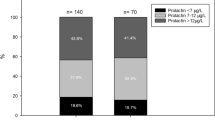Abstract
Secretion patterns of LH and prolactin were studied in 5 nonobese (group A) and 7 obese (group B) women with polycystic ovaries (PCO) by taking blood samples at 15-min intervals for 6 h. Serum LH level showed a distinct pulsatility in all patients. There was no significant difference in the mean pulse rate of LH between group A (6.2 ± 0.45, mean + SE) and group V (5.8 + 0.24). A pulsatile secretion pattern in prolactin was also found in 11 of the 12 PCO patients studied, the pulse rate being 3.2 ± 1.0 in group A and 3.9 ± 0.45 in group B. 79% of prolactin pulses coincided with those of LH but their amplitude was significantly lower than that of LH. In the total group of PCO patients a positive correlation was found between the serum concentrations of prolactin and free estradiol (r = 0.85), and prolactin and estrone (r = 0.78) indicating that estrogens participate in the regulation of prolactin secretion in polycystic ovarian disease. Four patients showed a steep decrease in the plasma prolactin level at the beginning of the study period suggesting a sensitive stress response.
Similar content being viewed by others
References
Rebar R., Judd H.L., Yen S.S.C., Rakoff J., Vandenberg G., Naftolin F. Characterization of the inappropriate gonadotropin secretion in polycystic ovary syndrome. J.Clin. Invest. 57: 1320, 1976.
Lobo RA, Granger L., Goebelsmann U., Mishell D.R. Elevations in unbound serum estradiol as possible mechanism for inappropriate gonadotropin secretion in women with PCO. J. Clin. Endocrinol. Metab. 52: 156, 1981.
Falaschi P, Del Pozo E, Rocco A., Toscano V, Petrange-li E., Pompei P., Frajese G. Prolactin release in polycystic ovary. Obstet. Gynecol. 55: 579, 1980.
Vermeulen A., Stoica T., Verdonck L. The apparent free testosterone concentration. An index of androgenicity. J. Clin. Endocrinol. Metab. 33: 759, 1971.
Yen S.S.C. The polycystic ovary syndrome. Clin. Endocrinol. (Oxf.) 12: 177, 1980.
Corenblum V., Taylor P.J. The hyperprolactinemic polycystic ovary syndrome may not be a distinct entity. Fertil. Steril. 38: 549, 1982.
Quigley M.E., Rakoff J.S., Yen S.S.C. Increased luteinizing hormone sensitivity to dopamine inhibition in polycystic ovarian disease. J. Clin. Endocrinol. Metab. 52: 231, 1981.
Bäckström C.T., McNeilly A.S., Leask R.M., Baird D.T. Pulsatile secretion of LH, FSH, prolactin, oestradiol and progesterone during the human menstrual cycle. Clin. Endocrinol. (Oxf.) 17: 29, 1982.
Aksel S. On the correlation of luteinizing hormone-releasing hormone, luteinizing hormone, and prolactin levels in plasma of women with normal menstrual cycles. Am. J. Obstet. Gynecol. 141: 362, 1981.
Cetel N.S., Yen S.S.C. Concomitant pulsatile release of prolactin and luteinizing hormone in hypogonadal women. J. Clin. Endocrinol. Metab. 56: 1313, 1983.
Libermann M.E., Maurer R.A., Gorski J. Estrogen control of prolactin synthesis in vitro. Proc. Natl. Acad. Sci. USA 75: 5946, 1983.
D’Agata R., Gulizia S., Vicari E., Aliffi A., Polosa P. Effect of androgens on prolactin (PRL) release in humans. Acta Endocrinol. (Kbh.) 90: 409, 1979
Adler R.A., Noel G.L, Wartofsky L., Frantz A.G. Failure of oral water loading and intravenous hypotonic saline to depress plasma prolactin in man. J. Clin. Endocrinol. Metab. 41: 383, 1975.
Moult P.J.A., Dacie J.E., Rees LH., Besser G.M. Prolactin pulsatility in patients with gonadal dysfunction. Clin. Endocrinol. (Oxf.) 14: 387, 1981.
Lorenzo E.M. Familial study of hirsutism J. Clin. Endocrinol. Metab. 31: 556, 1970.
Author information
Authors and Affiliations
Rights and permissions
About this article
Cite this article
Laatikainen, T., Tulenheimo, A. Prolactin pulsatility in polycystic ovarian disease. J Endocrinol Invest 8, 157–161 (1985). https://doi.org/10.1007/BF03350674
Received:
Accepted:
Published:
Issue Date:
DOI: https://doi.org/10.1007/BF03350674




